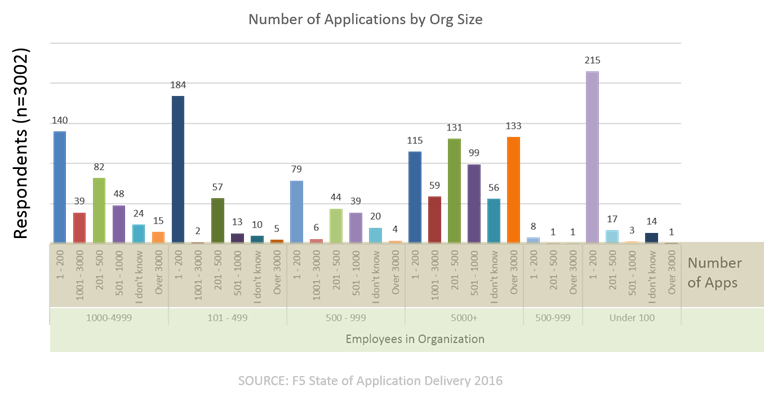
Server monitoring software is designed to optimize performance and availability across the network, but achieving this overarching goal is often easier said than done. Consider the exploding application sprawl according to the 2016 State of Application Delivery survey conducted across over 3000 responding organizations globally.

According the survey, 54 percent of the respondents are responsible for delivering up to 200 applications, 15 percent handle up to 1000 applications and 9 percent take care of up to 3000 or even more applications within their network. According to earlier Forbes' research, the average enterprise was already using over five hundred applications by the year 2014.
It makes sense to believe that application sprawl is inherently correlated with server sprawl. In fact, the 2016 State of Application Delivery survey also identified – albeit inexplicitly – that an average number of virtual server deployments within an organization was 122. And the highest number crossed 12,000 for large enterprises.
In today’s application-centric world, IT teams are responsible for addressing the key prerequisites of Agile or DevOps-driven work environments that include visibility, automation and accountability of the underlying network resources. This means that traditional server monitoring tools no longer suffice in maintaining high-performance, resilient and always-available network resources. To sum up, the core principles of advanced monitoring solutions are simple:
- Identify problems fast, proactively and accurately.
- Portray a clear and consumable picture of the entire infrastructure, to a granular level.
- Necessitate as little effort input as possible.
- Help truly optimize the network resources, processes and usage.
However, the functionality requirements to achieve these capabilities becomes increasingly sophisticated as organizations rely on a growing, complex and distributed network infrastructure to meet their IT needs. In this context, the following considerations drive the decision-making process for server monitoring software solutions:
1. Ease of Deployment and Usability
Network expansion is planned around the performance information of existing infrastructure set up. With the expanding network framework, organizations need to enhance network monitoring capabilities accordingly. This makes the ease of deployment, usability and maintenance of server monitoring software critical and consistent for the scaling network infrastructure. For instance, some cost-effective and popular open source monitoring solutions are easy deployed initially but require manual configuration every time new components are added. A single pane of glass view of the holistic monitoring information delivered in an intuitive format and with granular details significantly enhances the usability of server monitoring tools.
2. All-In-One Monitoring
Tools that offer an exhaustive set of features out-of-the-box prevent the need for installing add-ons and external plugins to meet the desired functionality goals. The effectiveness of server monitoring solutions is greatly reduced when IT professionals need to keep an eye on multiple aggregated interfaces resulting from the multiple add-ons. Tools that offer transparent conclusions distilled down from the vast deluge of data generated across multiple network endpoints at a simple glance are far more valuable for fast-growing organizations. However, a one-size-fits-all monitoring solution doesn’t exist in the market and organizations inevitably require multiple tools to achieve different monitoring capabilities. As such, technologies that enable unified workflows between multiple, well-integrated server monitoring software help overcome these limitations effectively.
3. Automation Capabilities
Proactive monitoring inherently depends on the ability to reduce manual efforts and improve response times. This is achieved when the monitoring solutions offer adequate automation capabilities built-in. Look out for features such as automated device discovery and monitoring provision, incident resolution and IT infrastructure automation, among others. Flexibility to customize through coding can allow users to develop unique monitoring use cases and automate workflows. However, relying on customizations excessively may impact the usability and maintenance of the solution within growing network frameworks and may necessitate a steep learning curve for new users.
4. Intelligence and Accuracy
Complex and dispersed network resources generate data at every node. And in the big data cosmos, the resulting information is overwhelming for IT teams to make sense and draw useful conclusions. A high level of accuracy is required to cut through the clutter of noise – false alarms and triggers – that disrupt otherwise smooth infrastructure operations. Analytics and predictive capabilities prove crucial in identifying problems before they impact and help maintain availability of the sprawling server resources with minimal efforts on part of end-users.
5. Cost and Licensing Model
Cost could be a crucial deciding factor for most enterprises investing in server monitoring software and the industry offers a wide range of solutions with varied licensing options – commercial open source, proprietary, cloud-based and on-premise deployments. Extensive research and accurate planning of your network is a necessary requirement to ensure the operating cost and functionality of the tooling remain aligned with your strategic business goals through the future. It is important to note that the cost of advanced solutions is often justified by the resulting ability to optimize network resources, minimize risks of downtime and streamline network infrastructure operations.
Every individual server monitoring tool performs differently on the aforementioned considerations and many organizations may eventually resort to multiple solutions to meet the desired functionality and feasibility requirements. To enable effective operations with multiple technologies, Evanios works as a manager of managers, a solution that integrates multiple monitoring solutions through either pre-packaged integrations or APIs, and hooks into your ITSM system to enrich event, metric and log data with CMDB, Incident and Change Management information. As a result, Evanios offers a single pane of glass view and control across multiple tools, which allows organizations to make the most out of every option available to them – without having to compromise on any given consideration for their server monitoring software investments.




